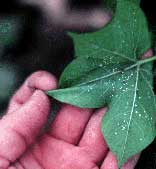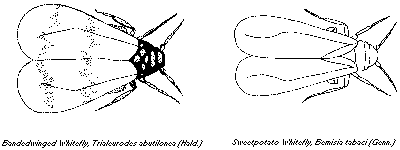
Whitefly Management Starts With Sampling
Because whitefly numbers in cotton can vary from year to year, sampling helps you avoid costly errors associated with whitefly control:- making unnecessary treatments, and
- treating populations too late to achieve adequate control.
Action Thresholds & Percent Infested Leaves
Research shows that insecticides should be applied when a threshold density of 5 whitefly adults per leaf is present. However, counting exact numbers of adult whitefly on every leaf is time-consuming and unneccessary. Because a predictable relationship exists between numbers of adult whiteflies per leaf and the percentage of leaves infested with just three or more whitefly adults, no more than three whiteflies need to be counted on a given leaf. This method increases sampling efficiency and has been confirmed on over 8000 acres of commercial cotton under a wide variety of field conditions.
HOW TO SAMPLE
- DESIGNATE MANAGEMENT UNIT
The size of the area to sample for whiteflies will depend on your management practices. A management unit is a fairly uniform area of the same cultivar planted at about the same time. This sampling plan is for an average field size of 40-80 acres. If your field is larger than this, take samples from additional sites within the field. Also, if you plan to implement control in field edges and field centers separately, then these two areas should be designated as separate management units and sampled separately. Sample at least weekly. Samples can be taken any time of day, but samples taken within 24 hours after a rain may not accurately reflect whitefly densities.
- CHOOSE A PLANT TO SAMPLE
Start sampling at least 10 rows into the field. Avoid sampling plants disturbed by sweep sampling. Choose a plant at random taking care not to single out tall or heavily infested plants. If you intend to treat field edges separately, select plants within the first 10 rows.
- CHOOSE A LEAF
Once a plant is selected, choose a single main stem node leaf from the general region of the fifth node down from the terminal-the first unfolded leaf is main stem node #1 (Figure 1). Count the nodes on a couple of plants before you begin sampling to familiarize yourself with the approximate position of the fifth main stem node. Then make observations from leaves within that general area of the plant.

- MAKE WHITEFLY COUNTS
Keeping your shadow off the plant, carefully turn the leaf over by the tip of the leaf blade or the petiole. Tally the leaf as “infested” if it contains 3 or more whitefly adults and as uninfested if it contains less than 3.
- SAMPLE AT LEAST 30 PLANTS
Continue sampling along a diagonal or zigzag line moving over several rows and taking 5-10 steps before selecting a new plant. The individual plants sampled should be 10- 15 feet apart. After sampling 15 plants, move to a new site within the field and sample 15 more (Figure 2).
- CALCULATE THE PERCENTAGE OF INFESTED LEAVES
% infested = infested leaves X 100 total leaves sampled
- COMPARE THIS PERCENTAGE TO THE THRESHOLD OF 57%
Average Infested Adults/Leaf Leaves* ---------------------------------------- 1 14% 2 28% 3 39% 4 49% 5 57% 6 64% 7 70% 8 75% 9 79% 10 82% ---------------------------------------- * An infested leaf has 3 or more adults.Track your population relative to the recommended threshold of 5 adults per leaf. This threshold corresponds to 57% of leaves infested. The adjacent table shows the relationship between average adults per leaf and percentage of leaves infested. Treat the field if your observed percentage is greater than 57% and do not spray if it is less. If the observed percentage is close to the threshold, then you may want to take additional samples from another site in the field and re-calculate the percentage. Continue sampling weekly, treating whenever the threshold is reached.
Count Sweetpotato Whiteflies Only !

Do not include bandedwinged whiteflies in your whitefly counts because they rarely warrant pesticide treatment. The bandedwinged whitefly is often found in cotton, wild sunflower, weeds, or melons in the early spring and summer. It has gray-colored bands on the wings, while the sweetpotato whitefly has no bands. The body of the adult bandedwinged whitefly is ashen-gray in color while the sweetpotato whitefly is a creamy-yellow color.
Issued in furtherance of Cooperative Extension work, acts of May 8 and June 30, 1914, in cooperation with the U.S. Department of Agriculture, James A. Christenson, Director Cooperative Extension, College of Agriculture and Life Sciences, The University of Arizona.
The University of Arizona is an equal opportunity, affirmative action institution. The University does not discriminate on the basis of race, color, religion, sex, national origin, age, disability, veteran status, or sexual orientation in its programs and activities.
Any products, services, or organizations that are
mentioned, shown, or indirectly implied in this web document do not imply
endorsement by The University of Arizona.
Questions concerning this publication can be addressed to: peterell@ag.arizona.edu
Cotton Insects | Cotton Insect Pubs | Cotton Insect Data | Stickiness | Advisories | Pesticides | Photos
Home | Cotton | All Insects
document located at: http://cals.arizona.edu/crops/cotton/insects/wf/wfsampl.html
Copyright © 2001 University of Arizona,
College of Agriculture and Life Sciences
Webmaster: Al Fournier (acis@ag.arizona.edu)